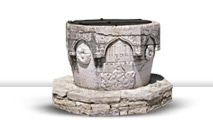
- Sečovlje Salt Pans - Dragonja River Valley
- Sv. Peter - Nova vas - Padna
- Pomjan - Nature Park: Karst Edge - Socerb
- Črni Kal - Osp - Kubed
- Momjan - Grožnjan - Pietrapelosa - Mirna
- Baštija - Kostanjica - Parenzana
- Oprtalj - Završje - Livade - Zrenj
- Istarske toplice - Motovun Forest - Višnjan
- Cave Mramornica - Feštini Kingdom - Cave Baredine
- Lim Bay - Kloštar - Kontija - Dvigrad
- Kanfanar - Bale - Palud - Vodnjan -Islands Brijuni - Fažana
- Svetvinčenat - Tinjan - Pićan - Gračišće
- Belaj - Šumber - Kožljak - Paz
- Čepićko Field - Kršan - Boljun Castle - Lupoglav
- Plomin - Kvarner Gulf - Brseč
- Nature park Učka - Mošćenice
Momjan - Grožnjan - Pietrapelosa - Mirna
Momjan
Presently dilapidated and ivy-grown, the castle can hardly evoke the power and wealth of the life that characterized it. It was built above the abyss overlooking the Dragonja River, defending against the enemy, a role it perseveringly justified for centuries. The most significant period of its life were the Middle Ages when Istria was divided between the Patriarchs of Aquileia, Venice and the Counts of Gorizia, living among their constant struggles for dominance.
As a village, Momjan was mentioned as early as the 11th c. The original defense-tower became a castle in the first half of the 13th c. and along with the nearby Kostel protected the area from Piran pretensions.
The owners of Momjan, the family of Woscalc from Devin and sons, were known for their fickleness and expressed their affiliation depending on interests. Fitting nicely into this feature was their constant desire to gain political functions – they were the podestà in Piran, Buje, Poreč and Motovun. They were known for their disputes and conflicts with neighbors, mostly over possessions, dominance and power, and often fought and changed sides between the Counts of Gorizia and Patriarchs of Aquileia.
Almost a cursed town, it constantly changed owners, the property was mortgaged, returned, but always important and mentioned. Truly, mostly in deeds of gift or inheritance documents. This is where the oldest copy of the Survey of Istrian Land Boundaries (Istarski razvod) in ItaIian was found.
With the appearance of fire arms, Momjan started to loose its significance as a defense tower and became a watchman's station. Although naturally protected by a deep abyss, that divides it from the plateau on which the village was formed, it became an ideal cannon target from the somewhat higher hill of St. Maurus.
In the 16th c. it was bought by the Rota family. They thoroughly restored the castle adding two fine buildings inside the walls. The wooden drawbridge over the abyss was replaced by a nice stone bridge, and the entrance was reconstructed and bore the family coat of arms. This is when the detailed listing of land possessions began, known as the Momjan catasticum (Momjanski katastik), in order to present the owner all the property and rights he was entitled to. Until the 19th c. the castle had a residential function, after which it fell into decay because the Counts of Rota moved to a more comfortable palace in the village. In addition to the palace, the Parish Church of St. Michael from the 15th c. is equally interesting particularly for its fine pulpit from that period.
Today, only the ruins of the castle, that along with the adjoining houses are referred to as the lower town, serve as reminder of Momjan's glorious past The nearby area abounds in maintained vineyards that on the sun-soaked slopes create beautiful images, reflect the wealth of the area and the imprint of its hard working people. Of the one-time 60 mills and watermills that stood here, only several are preserved on the dried up stream, which speak of the magical landscape and the tale spun around Istrian rivers.
Print page Send to a friend



















